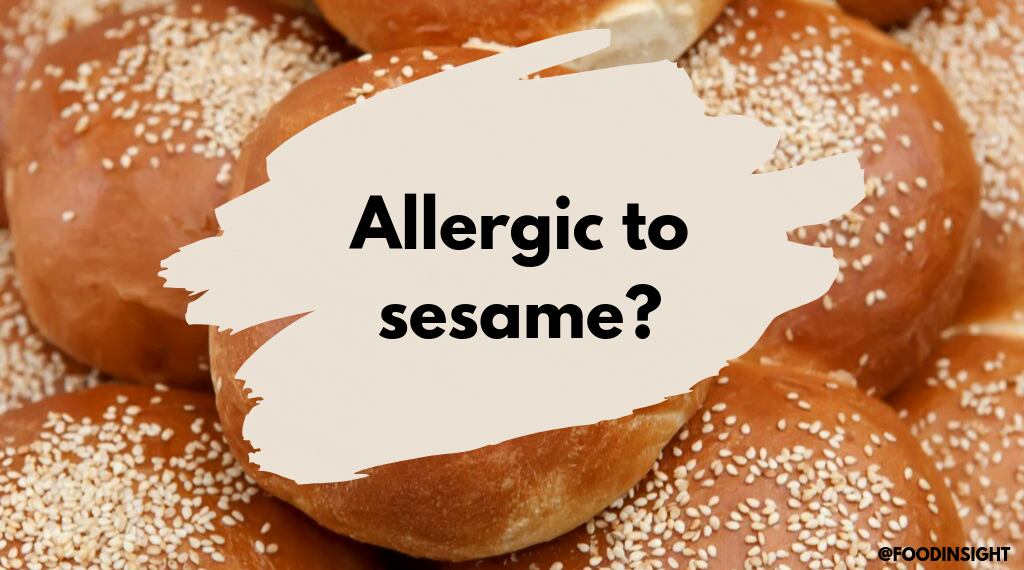Ahh, sesame. We all know those pale, tiny seeds that sit on top of hamburger buns, speckling them with bursts of flavor and texture. But sesame is used for much more than making your buns more fun. It is also used in other popular, everyday dishes. You can find sesame in hummus as a smooth paste called tahini or as a mouth-watering finishing oil used in Asian-inspired dishes.
In the news
Sesame has been on the tip of everyone’s tongue recently—not only as a food ingredient, but also as a topic of conversation. Recent studies suggest that nearly 1.5 million Americans could have a sesame allergy. If so, this leaves 0.49% of our population at risk of an allergic reaction to sesame-containing foods. Food allergy symptoms can range from mild skin irritations and hives to life-threatening anaphylaxis. Increased attention to sesame allergies may leave you wondering if sesame should be labeled as the ninth most common food allergen in the U.S. Should processed foods include warning labels for foods containing this popular ingredient? Should restaurants and retail establishments inform you about the presence of sesame in your meal? The state of Illinois seems to think so.
New state regulations for sesame
Unlike the Big Eight, the FDA does not currently recognize sesame as a major food allergen nor require it to be labeled as an allergen on food labels. In time, this could change.
Illinois recently became the first U.S. state to require sesame allergen labeling. This decision makes Illinois the first and only state in the U.S. to require sesame to be labeled as an allergen. Such labeling already is required globally in Canada, Europe, Australia, New Zealand and Japan. These regulations are due in part to the fact that sesame-containing foods are widely consumed in these regions, resulting in high prevalence rates. For example, the rates of accidental exposure to sesame and peanuts are comparable (15.9%) among Canadian children.
The U.S. may not be far behind in its sesame-labeling requirements. The U.S. Food and Drug Administration (FDA) is currently considering changes to the Food Allergen Labeling and Consumer Protection Act (FALCPA), which could allow sesame to be added to the current list of eight allergens required to be labeled. In the fall of 2018, the FDA asked for public input regarding the prevalence and severity of sesame allergy in the U.S. as well as the sale of sesame-containing foods. The information it gathered may be used to decide the future of sesame labeling for the entire U.S. We’ll find out what the FDA decides soon enough. Until then, if you think you have a sesame allergy, there are a few practical steps you can take to remain safe.
If you are experiencing an allergic reaction to sesame or any other food, dial 911 and seek immediate medical attention. A medically trained professional can evaluate your symptoms and request a diagnosis from an allergist to confirm a food allergy.
Think you have a sesame allergy?
Remember, there’s no need to avoid sesame if you’re not having a reaction to it. But if you or your family have a history of food allergies, sesame may be a concern. Here are a few practical steps you can take if you suspect you are allergic to sesame or any other common food allergen:
Visit an allergist
- Only a board-certified allergist can provide an official food allergy diagnosis. It is important to visit one as soon as possible if you believe you have a sesame allergy or any other food allergy. Self-diagnosing allergies can lead to unnecessary diet restrictions, which no one wants. Why avoid certain foods when you don’t have to?
Read food labels
- Reading food labels can help you identify the presence of allergens in the product. If the product contains one or more of the top eight allergens, they’ll be listed.
Keep a food diary
- It may be helpful to log your food intake along with any food allergy symptoms you experience in a food diary. Allergists often use food diaries to help them identify potential food allergies and intolerances.
Foods that contain sesame
Many foods are made with sesame as an ingredient, which is why it’s important to read the label when shopping for food. Below is a list from Food Allergy Research and Education (FARE) of foods that may contain sesame as an ingredient.
- Asian cuisine (sesame oil is commonly used in cooking)
- Baked goods (such as bagels, bread, breadsticks, hamburger buns and rolls)
- Breadcrumbs
- Cereals (such as granola and muesli)
- Chips (such as bagel chips, pita chips and tortilla chips)
- Crackers (such as melba toast and sesame snap bars)
- Dipping sauces (such as baba ghanoush, hummus and tahini sauce)
- Dressings, gravies, marinades and sauces
- Falafel
- Hummus
- Flavored rice, noodles, risotto, shish kebabs, stews and stir fry
- Goma-dofu (Japanese dessert)
- Herbs and herbal drinks
- Margarine
- Pasteli (Greek dessert)
- Processed meats and sausages
- Protein and energy bars
- Snack foods (such as pretzels, candy, Halvah, Japanese snack mix and rice cakes)
- Soups
- Sushi
- Tempeh
- Turkish cake
According to FARE, “Allergens are not always present in these foods and products, but sesame can appear in surprising places.” Their advice stresses reading food labels and asking about ingredients when you are unsure.
On the horizon
We are awaiting the FDA’s decision on sesame labeling, which could include changing the look of current food labels. Food Insight will continue to monitor this issue and update as we know more.
This article is written by Casey Terrell, MPH, RD.

